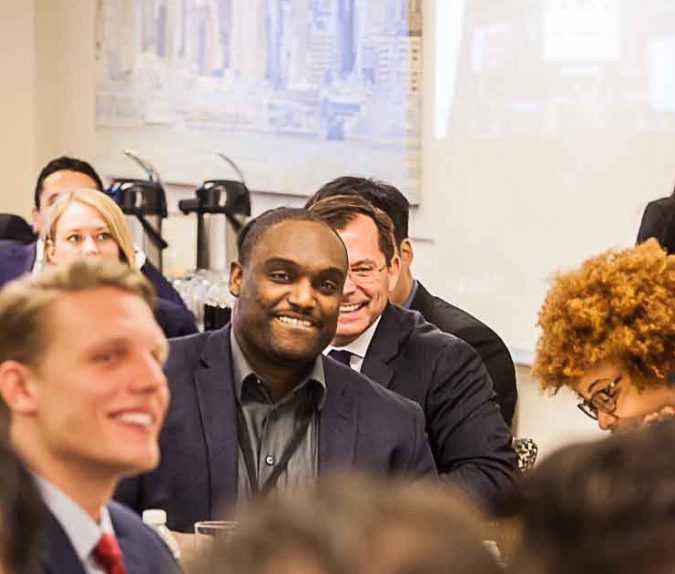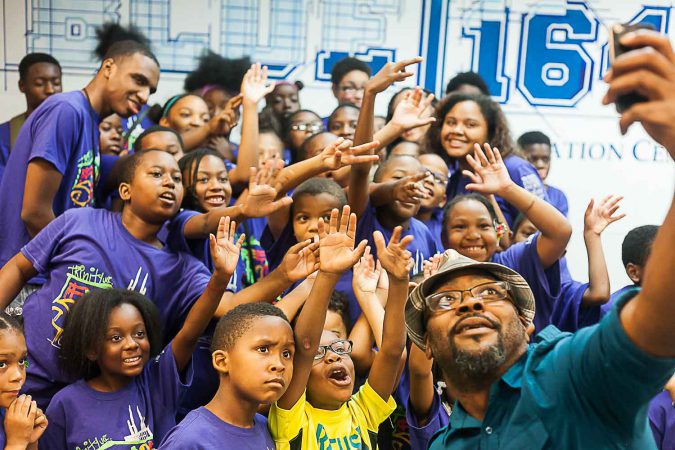Nearly four years ago, a small, obscure start-up innovation hub was stationed on a low-key part of the Blue Island Avenue business strip in the Pilsen community.
Emile Cambry Jr., a faculty member of DePaul University at the time, had a vision to create a space that would bring together other like-minded creatives to have shared office space and host occasional workshops for neighborhood youth.

As the founder of Blue 1647, Cambry’s social innovation center has rapidly grown to include several programs that teach both adults and students about HTML coding and entrepreneurial workshops, providing a platform for filmmakers, artists, engineers and designers to host networking events. The ”Blue” print, their unique model for applying quality programming for people in various levels of their academic and professional lifestyle, has helped them launch in other markets, such as St. Louis, Compton, Milwaukee, Haiti and, soon, Brooklyn, New York.
Growing Out of Space
With the assistance of a young and charismatic staff, the story of Blue 1647 has garnered international recognition, attracting government officials, ambassadors and successful business people. Since its inception, the home of the growing tech and innovation center has taken a leap in acquiring massive space a mile away at Lacuna Lofts.
Cambry says, “The biggest challenge was that we have the youth and adult programs. Both programs are getting larger and they started to conflict with each other on a space perspective. We wanted to do more, so we needed to find a bigger space. We ended up being introduced to the Cacciatore family and really vibing with them on what the space could be,” he said. “What I look at as a town hall for social innovation is an opportunity for adults to be able to have a space that looks cool, that’s funky, but has a lot of events and workshops so we can take things to the next level.”
 Since the soft launch of Blue Lacuna in early January, they have been diligently working on expanding the company capabilities to accommodate the weekly workshops and interactive arts programs that are on the spring/summer schedule.
Since the soft launch of Blue Lacuna in early January, they have been diligently working on expanding the company capabilities to accommodate the weekly workshops and interactive arts programs that are on the spring/summer schedule.
The new loft-style space is along the industrial corridor of Cermak Road, west of Halsted, where old factories have been converted to hip office and artist workspaces, attracting self-start businesses to fill the units. Cambry admits it wasn’t an easy transition when they moved into the predominantly Mexican community four years ago.
“It was a challenge because I think it shocked a lot of people. It’s still Chicago — segregated Chicago. Why is a Black guy trying to start a tech incubator that’s inclusive in a Mexican-American community? Because that’s why we needed to do it. I felt that two-thirds of the city are underrepresented minorities. It only makes sense that we find a way to bring both in.”
The New Normal
Across town, tech incubator hubs such as 1871 had the financial muscle and backing that drew more attention than centers such as Blue 1647, but that didn’t discourage Cambry.
“I’m never going to get the other demographic, so let me focus on a core group that’s not being served, but it took time. We had to do a lot of events, workshops and me telling the story about what we’re going to do. Some people believed in us. At first, I didn’t know if I was going to do it, but we are going to try. Now, people are noticing and we can focus on effecting change. I’m trying to convince people that Black and Brown people want to do tech.”
Amber Green is the media department director for the center, a photographer and a small-business owner. She began her relationship with Blue 1647 volunteering and still currently teaches photography classes. She has witnessed firsthand the accelerated pace of growth of Blue 1647 and how the community has gradually embraced its programs for their youth.
“We’re starting a new series, hashtag #thenewnormal, where every day Black and Brown excellence is an everyday experience. We want to feature Black and Brown excellence within the community, even if they’re not attached to Blue Lacuna, so that people on the other end of the video camera can see any and every day folks in the community — from Englewood, Hyde Park to Roseland — and how they are doing well. You don’t hear this in the mainstream media. The first thing you hear in Chicago is the violence,” Green explained.
 Positive Role Models
Positive Role Models
A single mother, Green takes pride in how Blue Lacuna has influenced her 8-year-old son’s life. “What’s so amazing about Blue, as [women], we don’t always see positive images of our Black men. Who would’ve thought that a powerhouse like Blue 1647 has been founded and operated by Black men?” She says being around such powerful role models, her son has “adopted 10 uncles and eight brothers and cousins.”
Green added. “He’s walking differently, he’s talking differently with more confidence. I love the culture here; everybody’s child is our child and everybody who comes in is going be held accountable.”
As they restructure the website to provide additional courses to help new and existing professionals polish their skills in the tech-savvy arena, Blue 1647 has expanded their services to the south suburbs. They opened a satellite hub in Dolton on April 19.
Cambry is excited about the attention and demand of helping other organizations apply the same model of success within their communities. His schedule is non-stop and his frequent flier points will soon be applied to his upcoming honeymoon. The Men of Excellence award recipient became recently engaged to Kelley Williams, who began a STEM start-up program teaching youth under 8.
“The great thing now is that we can partner together on initiatives that we’ve been able to do in the past. Moving forward, we can help build together, that’s the cool thing to tell in this story. Black people can build a business, get married and can help each other, too. That’s what I’m really excited about,” said Cambry.
“If we don’t solve our problems in our community from our homes — not to say every home must be perfect, but I want to be an example of what can happen when Black people can be on the same page.”
Follow Mary L. Datcher on Twitter